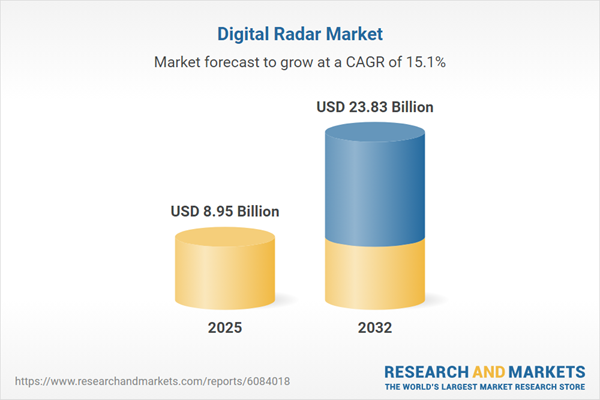Speak directly to the analyst to clarify any post sales queries you may have.
The digital display market is amid significant transformation, propelled by advances in display technology and the integration of data-driven platforms. This evolution is requiring senior leadership to address competitive trends, regulatory shifts, and emerging end-user requirements for greater business impact.
Market Snapshot: Digital Display Industry Growth and Overview
The digital display market is experiencing strong expansion, with revenues growing from USD 7.75 billion in 2024 to USD 8.95 billion by 2025. Long-term forecasts project a sustained CAGR of 15.06%, culminating in a market value of USD 23.83 billion by 2032.
This rapid growth is fueled by the intersection of next-generation hardware, the adoption of intelligent content management solutions, and widespread implementation across industries such as retail, transportation, entertainment, and emerging smart city developments. Leaders must remain vigilant as evolving competitive landscapes create both risk and opportunity for incumbents and new entrants.Scope & Segmentation
This report provides an in-depth analysis of the full digital display ecosystem, spanning critical products and services, deployment approaches, applications, and end users. Stakeholders gain a granular understanding of the factors influencing market dynamics in established and emerging regions.
- Hardware Types: LCD digital posters, LCD video walls, indoor and outdoor LED displays, projectors. These solutions drive digital transformation in high-visibility environments, meeting expectations for quality and flexibility.
- Services: Consulting, installation and integration, support and maintenance. Service providers underpin seamless system rollouts and ensure ongoing functionality.
- Software: Analytics, content management, device management. Enhanced software delivers efficiency, enabling data-driven decision-making and centralized control.
- Deployment Models: Cloud, on-premises. Choices reflect organizational priorities for scalability, data security, and ease of management.
- Applications: Advertising, entertainment, information delivery, transportation. Versatile displays support diverse objectives, from branding in retail to wayfinding in airports.
- End Users: BFSI (banking, financial services, and insurance), healthcare, retail, transportation and logistics. Each sector leverages displays to enhance engagement, deliver targeted information, and streamline experiences.
- Regional Coverage: Americas (United States, Canada, Mexico, Brazil, Argentina, Chile, Colombia, Peru), Europe, Middle East & Africa (United Kingdom, Germany, France, Russia, Italy, Spain, Netherlands, Sweden, Poland, Switzerland, United Arab Emirates, Saudi Arabia, Qatar, Turkey, Israel, South Africa, Nigeria, Egypt, Kenya), and Asia-Pacific (China, India, Japan, Australia, South Korea, Indonesia, Thailand, Malaysia, Singapore, Taiwan). Regional trends reflect economic development, infrastructure investment, and regulatory environment.
- Leading Companies Examined: Raytheon Technologies Corporation, Lockheed Martin Corporation, Northrop Grumman Corporation, Thales Group, Leonardo S.p.A., BAE Systems plc, Saab AB, HENSOLDT GmbH, Rafael Advanced Defense Systems Ltd., Rohde & Schwarz GmbH & Co. KG. These organizations set benchmarks in technology integration and market presence.
Key Takeaways for Senior Decision-Makers
- Emerging digital display solutions such as microLED, transparent OLED, and advanced video walls are setting new benchmarks for hardware and elevating expectations across both critical and commercial environments.
- Adoption of cloud-based content management and device analytics is vital for optimizing performance, supporting remote visibility, and ensuring effective deployment across multiple sites.
- Interactive and immersive displays are increasingly favored to enable advanced data visualization, facilitate personalized communications, and enhance engagement in various settings.
- Regulatory themes, including energy efficiency and data privacy, are influencing product design and driving compliance strategies. Stakeholders are focused on sustainable and reliable solutions in light of these priorities.
- Organizations are leveraging dynamic pricing models and modular architectures to address volatility in supply chains, optimize capital investment, and remain responsive in a shifting competitive landscape.
- Partnerships with system integrators, software developers, and analytics specialists are broadening solution portfolios, accelerating technology implementation, and promoting value creation across sectors such as finance and urban infrastructure.
Tariff Impact: Navigating U.S. 2025 Policy Changes
New U.S. tariffs have reoriented global supply chains in the digital display sector, requiring manufacturers to rethink sourcing and production. Established players with diversified supply networks maintain greater stability, while new entrants explore partnerships and joint ventures for access to essential components. Increasingly, production for high-volume products like LED displays is being localized to align with regional market requirements as firms seek to limit logistical risk. These shifts enhance end-user bargaining power and encourage flexible pricing strategies, reflecting a broader drive toward resilience and adaptability across the value chain.
Methodology & Data Sources
Research is based on direct interviews with technology vendors, integrators, and prominent end users, complemented by secondary review of industry publications and regulatory documents. Quantitative analysis consolidates shipment, revenue, and pricing data to ensure a reliable market outlook. Multi-stage peer review verifies relevance and precision for current industry stakeholders.
Why This Report Matters
- Delivers segmented market intelligence, regional perspectives, and actionable guidance tailored to the decision-making needs of executives and strategy leaders.
- Presents thorough analysis of technology advancement, supply chain vulnerabilities, and evolving compliance standards to support robust investment and operational decisions.
Conclusion
The digital display market’s continued advancement requires organizational agility in strategy and alignment across technology and services. Stakeholders who adapt to these shifts will unlock new value as the market ecosystem diversifies.
Table of Contents
3. Executive Summary
4. Market Overview
7. Cumulative Impact of Artificial Intelligence 2025
Companies Mentioned
The companies profiled in this Digital Radar market report include:- Raytheon Technologies Corporation
- Lockheed Martin Corporation
- Northrop Grumman Corporation
- Thales Group
- Leonardo S.p.A.
- BAE Systems plc
- Saab AB
- HENSOLDT GmbH
- Rafael Advanced Defense Systems Ltd.
- Rohde & Schwarz GmbH & Co. KG
Table Information
| Report Attribute | Details |
|---|---|
| No. of Pages | 199 |
| Published | October 2025 |
| Forecast Period | 2025 - 2032 |
| Estimated Market Value ( USD | $ 8.95 Billion |
| Forecasted Market Value ( USD | $ 23.83 Billion |
| Compound Annual Growth Rate | 15.0% |
| Regions Covered | Global |
| No. of Companies Mentioned | 11 |









